PROLOGUE | PERSONAL
Gwen, imagine if the pandemic did not currently dominate our lives and we could meet in your home or in your studio. Where do we talk together, where do we meet you? Probably in motion, comparing paintings while walking back and forth between my small and large studio. It’s on the top floor with north facing windows, overlooking Manhattan and Brooklyn. There will be a few paintings on the walls of each room, with many more facing the wall and in my storage rack. Maybe we are sitting at your favorite place? We are facing my largest wall at right angles to the windows where we can see the paintings without any glare. I offer you a cup of strong Scottish tea (or herbal).
Image. above: Artist in studio with “04.22.21, pale radiant orange on raw umber”, 48 in sq., 2021
Where do you come from, where were you born when? I was born in 1962 in Fife, Scotland and grew up in a beautiful rural area called Aberdeenshire. Surrounded by farms, we lived in ‘the big house’; an abandoned old schoolhouse and adjacent small school which my parents used as a painting and ceramic studio. My father had the brilliant idea of buying the entire school and schoolhouse from the local authorities for a small sum and bringing it back to life with his young family. How and where do you currently live and work? New York City, I live in the Upper West Side of Manhattan, and commute every day to the Gowanus area of Brooklyn. It’s funny but I think the commute time now is about the same door to door as it was back then to my school, Inverurie Academy, which involved a daily 15 minute walk past fields of cows down the hill to the school bus. Now I speed in the subway under Times Square, lower Manhattan, the Hudson River and re-emerge in the Gowanus area of Brooklyn. All in – then and now – just under an hour each way.

Which stations and people have shaped you? The four places I have lived and worked: Scotland, Berlin, London and New York.
Scotland gave me a love for nature, light, shadow, open spaces. At Edinburgh College of Art (1979 – 84), I studied the life model for five years. I knew I wasn’t going to become a traditional figurative painter but I found the task of translation from three to two dimensions and the privilege of studying a real live human being in front of me amazing. There was so much to learn about creating illusions in paint of light, shadow, skin, form.
In 1984 I was awarded a DAAD annual art scholarship to live and work in Berlin. This was a liberating time and I took on many new influences to expand my base of knowledge. The main influence was the expressionist painter Georg Baselitz who used to visit my studio and challenge and encourage me in equal measure. I admired Baselitz’s use of color, his intensity and the wild unconventional beauty of his work. We used to communicate through his secretary (with lots of gesticulation, a little laughter) because my German and his English were not great! Baselitz taught me quickly the value of breaking everything apart that I had learnt at art school. I trusted him because I wanted to expand the base from which I could develop and put everything back together again in a new way.
Mark Rothko has also been a source of inspiration. I first encountered his work in the Tate Gallery room dedicated to his Seagram paintings when I was 18 and sat in front of them for a long time as my heart and mind opened to their world. It was liberating that an artist could achieve such expansive emotional sensations in painting with so little means. Rothko’s influence resurfaced indirectly when my mother died and I found the courage, with some money she had left me, to move to NYC.

London is the city where a great friend introduced me to the Buddhist teachings of Vietnamese Zen master Thich Nhat Hanh. I find it difficult to listen to public talks so I couldn’t believe it when I found myself transfixed to the spot. I sat at the back of a huge church on a hard wooden pew listening to this person talking so gently and with such precision and depth that his voice cut right through me as if he were whispering in my ear! I went on mindfulness training retreats with him in France and had some extraordinary experiences in meditation; the Buddhist way of describing it might be a ‘shattering of the status quo’.

Oddly, New York is the city where I found a way to survive as an artist. Stable good studios are hard to come by and I had the good luck to know an enterprising and friendly landlord who let me design, construct and manage a group of studios on the top floor of his beautiful building in the Gowanus area of Brooklyn–it meant that I could create a dream studio while managing the entire floor.

Which writers do you currently find exciting and which books are on your bookshelf? Elena Ferrante – The Neapolitan Novels, Great biographies of artists such as “Matisse the unknown and Matisse the master” by Hilary Spurling, “Mark Rothko” by James Breslin. Which books have influenced or shaped you? Maybe none – I love reading but my sources of actual influence are more direct; life experiences and encounters with art/ painting/ relationships with people. What are you currently reading and where do you keep the book? Amos Oz ; “A Tale of Love and Darkness”, is by my bed. What music do you listen to and when? Classical – Bach piano and guitar music, Vivaldi, Satie, ancient music, world music, African Kora music, African highlife, Nina Simone, … and also some pop singers like Sinead O’Connor and William Onyabear- I put the music up louder when I am exhausted at the end of the day and need some energy to wash my brushes- during painting I prefer ‘non-climactic’ instrumental music or just quiet.

and 08.25.21 pale burnt umber on raw umber, (right), both 24 in sq
If you would cook something for us, what would it be? Maybe an arugula and fava bean risotto with lemon chili olive oil- it’s the most delicious recipe I have ever made with reliable success and was written by a wonderful chef who runs a vegetarian restaurant in Cork, Ireland. What do you like to eat most? Vegetables and olive oil. What do you think about breakfast? I am religious about it!, probably toast with brie and arugula and a caffe latte – a daily ritual with my stainless steel moka pot, Zabar’s dark roast espresso which I freshly grind and heated frothy milk. What kind of sport or counterbalance to your work do you practice? Swimming and more recently – gym workouts – walking in Central Park. Do you have special passions (hobbies) for which you are burning, and if so, which ones? Snorkeling in coral reefs – anywhere in the world. What personality trait defines you? Motivated.

INTERVIEW | ARTIST + POSITION
To begin, please tell us your artistic vita in a few sentences
I was awarded a DAAD Scholarship to study in Berlin after graduating from Edinburgh College of Art in 1984 and lived in Berlin till 1990. I lived in London 1990-1999 and have lived in NYC since 2000. Solo shows in London, include Fischer Fine Art, Annely Juda Fine Art and Beaux Arts and in Scotland; The Scottish National Gallery of Modern Art, The Talbot Rice and The Fruitmarket Gallery. Shows in NYC include Lennon Weinberg, Garis and Hahn and 57W57Arts. Upcoming shows include 57W57Arts in Feb /Mar 2022. My work is represented by ASAP Gallery in Rotterdam and Galerie Pugliese Levi in Berlin. ASAP shows my work in art fairs: Art The Hague and De Pan, Amsterdam. Public collections include the Metropolitan Museum of Art, British Museum, Scottish National Gallery of Modern Art and the Gulbenkian Museum in Lisbon.

Briefly explain your current project / the upcoming exhibition.
My current show in Berlin at Galerie Pugliese Levi presents a series of atmospheric square paintings. The title of the show, “Human Boundaries” simultaneously refers to the body’s outer edge of skin and inner spaces of the mind. Each work consists of a dominant, warmer foreground color, which appears to glow and subtly move on a cooler background color. The range of paintings show a spectrum from light to dark, warm to cooI, inspired by skin tones, light and shadow and experiments with the color wheel.
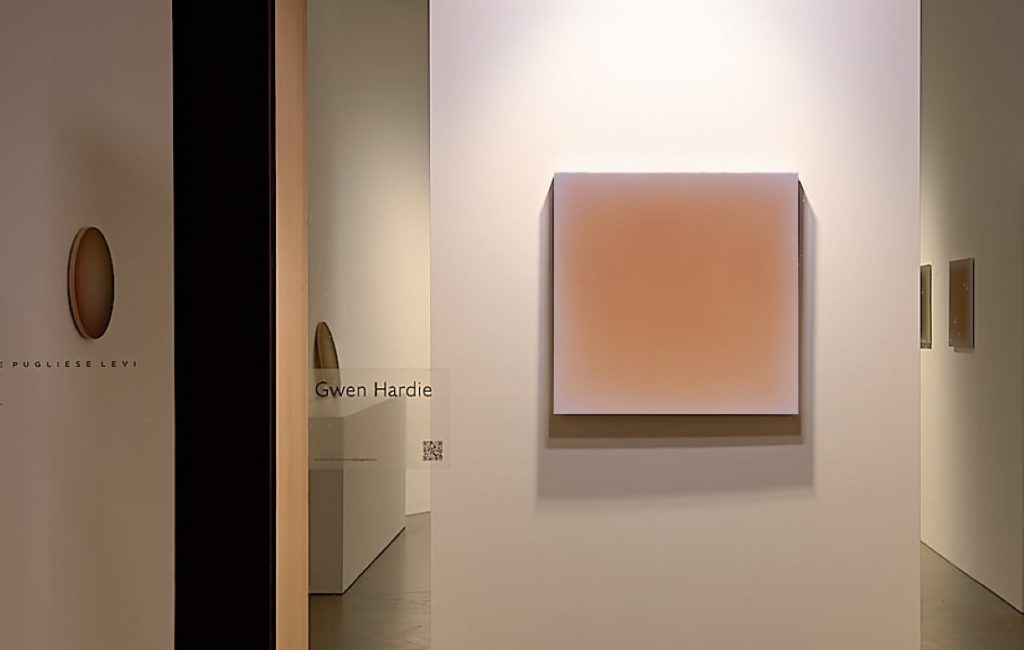
What are you currently most concerned about; what is on your mind?
I am always seeking a more perfect synthesis of form and meaning in my work. In other words–never satisfied!

“Human Boundaries” solo show, Nov 6 – Jan 8 2022
How did you come to art? Why art?
As a young child, I remember needing to draw the people close to me, my family my cat, myself – as if this concentration on the subject and the drawing made me feel more secure. It seemed to offer a steadier grip on life than I could otherwise experience. The ‘art’, if you can call it that at the time, was like a person who not only kept everything safely stored and never forgot anything learnt but gave me back revelations. This ‘relationship’ kept growing as I grew up.

What makes you happy at the moment?
Painting, my husband and trying to keep fit.
What is currently scaring you
Extreme right wing politics, racism come to mind first.
Do you believe that art has a social responsibility? And what do you think it can do?
I think of art as akin to science. There is freedom in art to think beyond mental constructs, which can push forward into new ways of thinking. Social responsibility can be woven into the fabric of an artist’s vision, but it can also burden the free – thinking nature of art. I like to think that art can have a subtle message within it, which affirms, gives hope, expands horizons.
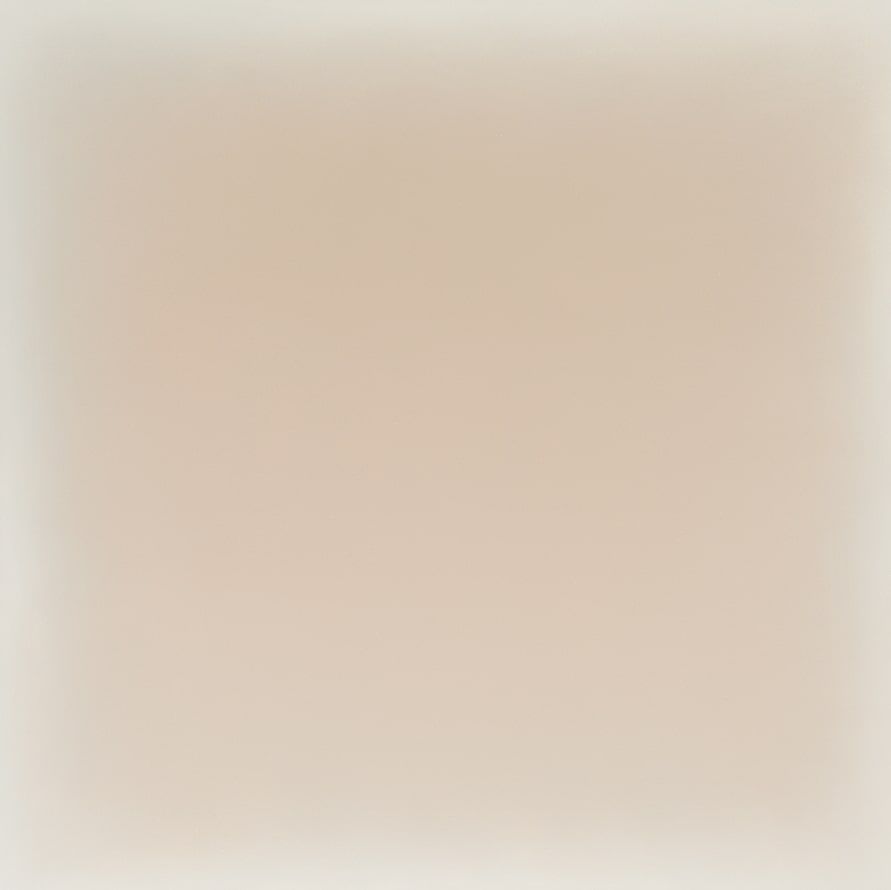
What makes your art special?
The trajectory of my work from observation-based closeups of the human form to the atmospheric color fields that I am now painting is unusual. The colors and tones I work with are garnered from many years of studying effects of sunlight and shadow on magnified portions of skin. Around 2015, I discovered I had enough information to create lifelike illusions without observing from a live model. My work became gradually more abstract and spare, moving further away from a literal representation of skin.

Since 2018, I have returned to the square format and further pared down my approach. Each painting creates an illusion of shifting depths of field between a dominant foreground color and a background color. I manipulate the gradients between these grounds to create an illusion that hovers between lifelike presence and atmosphere. The overall effect makes my paintings seem like living, breathing things. Maybe this is the most unusual or ‘special’ aspect of my art.

What is it about – what are the central themes of your work?
My work is about being and the act of perception. I work with colors that are inspired by the beauty of skin tones – the subtle glow of life, from dark to light, warm to cool. These colors speak directly to living and being because they are so intimately connected to our physical selves. In each painting, I blend one dominant foreground color over a background color to create an illusion of shifting depths and subtle movement between atmosphere and presence. When I refer to atmosphere, what I am really expressing in the painting is the dissolution of this physical presence or form – how it can appear at one moment as presence (form), then at the next moment, as atmosphere (formlessness). Perceptually, this acts as a kind of door opening inwards from the body to the unquantifiable spaces in the mind. Color is a great tool to convey this because it communicates directly through sense perception. The transitions between the grounds serve to place the foreground color in a state of hovering, detached from the picture plane, floating beyond it both backwards and forwards. Each painting radiates, expands, contracts, appears more or less dense, in its own particular way.
THE DEED | DAS WERK: Gwen Hardie
Gwen Hardie, who grew up in Aberdeenshire, Scotland and lives in New York, talks about the central message of her artistic work during her interview.
Gwen, please describe the core theme and the central message of your work
My work is about being and the act of perception. I work with colors that are inspired by the beauty of skin tones – the subtle glow of life, from dark to light, warm to cool. These colors speak directly to living and being because they are so intimately connected to our physical selves. In each painting, I blend one dominant foreground color over a background color to create an illusion of shifting depths and subtle movement between atmosphere and presence. When I refer to atmosphere, what I am really expressing in the painting is the dissolution of this physical presence or form – how it can appear at one moment as presence (form), then at the next moment, as atmosphere (formlessness). Perceptually, this acts as a kind of door opening inwards from the body to the unquantifiable spaces in the mind.
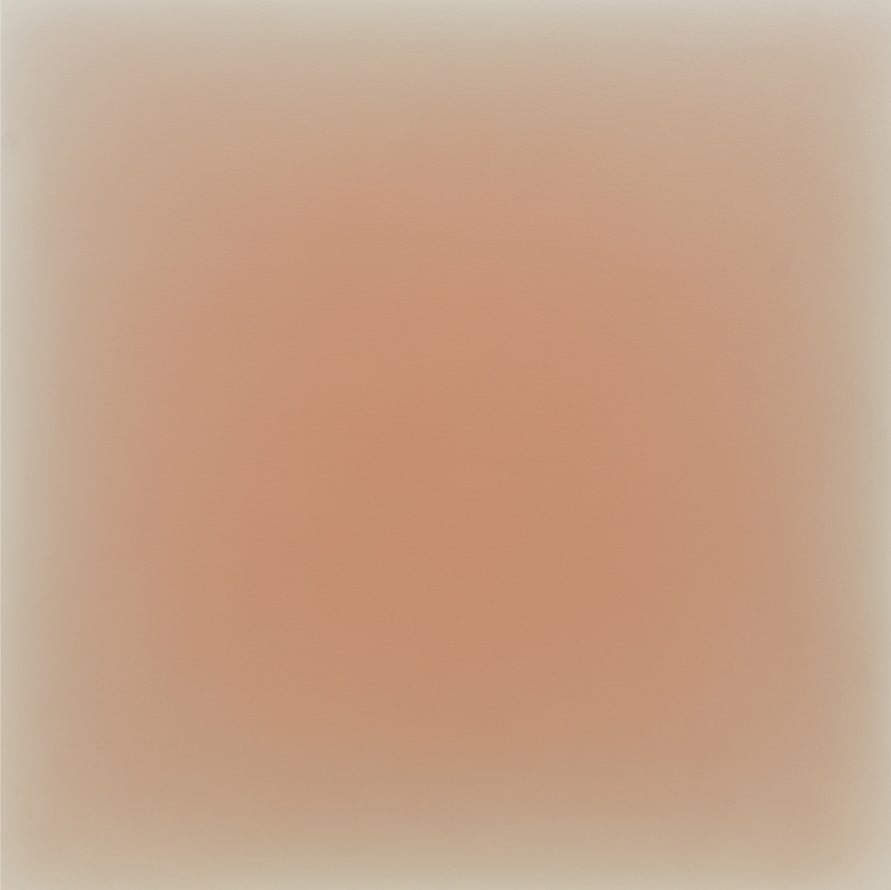
05.17.21, radiant pink on umber grey, 42 in sq, 2021
Color is a great tool to convey this because it communicates directly through sense perception. The transitions between the grounds serve to place the foreground color in a state of hovering, detached from the picture plane, floating beyond it both backwards and forwards. Each painting radiates, expands, contracts, appears more or less dense, in its own particular way.

05.21.21, pale cool pink on raw umber, 48 in sq, 2021
Introduce us to the work that, in your view, exemplifies or best embodies the message of your work
The two paintings above, ‘05.21.21, pale cool pink on raw umber’, 48 in sq and ‘05.17.21, radiant pink on pale umber grey’, 42 in sq. are good examples. If you compare them, one is more radiant than the other, but both share a similar skin tone, a cooler pinkish hue floating on an umber grey background.
Consider more closely 05.21.21. The raw umber background color is at its palest at the outer edge in all directions. Then, as you gradually move inwards, the raw umber increases in darkness in tiny gradients and starts to blend with the foreground color, which is at its most saturated in the central area of the painting. As the painting progresses I keep adjusting the radiance, saturation and tonal levels in every direction. Small adjustments in tone or saturation have an enormous effect, determining how the foreground color moves within the square. I bring it to completion by asserting the radiance of the pink foreground, then muting the pink until the painting reverberates exactly to the level I want.
The raw umber is a recent choice for the background of these and many new paintings because of its closeness in hue to the foreground color, which enables me to make more subtle gradients in these transition areas. Surprsingly, raw umber appears to take on a hint of the complimentary hue of the foreground color. Is it because I am manipulating the radiance levels of the foreground color as if under magnification, or is it to do with the way our eyes receive information about color?
As the painting film builds on the surface of the canvas the foreground color becomes more assertive, establishing itself at a certain density and radiance level that feels very particular. The canvas itself, the cloth, the square format represents a stable structure that grounds this animated illusion. I work with wide flat varnish brushes, each dedicated to its own colorspace. In these paintings, one brush will be for the palest raw umber I use from the outer edge inwards, another for the most saturated radiant pink from the center of the painting outwards, and the third for the transition color in between. These brushes enable me to blend fast and build up a unified film within hours.

Brushes on worktable
The final stage of the painting involves removing every last trace of brushmarks with two very soft wide blender brushes- one for the background outer edge, the other for the central area foreground color. The control of the color becomes so extreme that the slightest wrong move with the wrong brush and a millimeter of the wrong color ruins the atmospheric illusion.
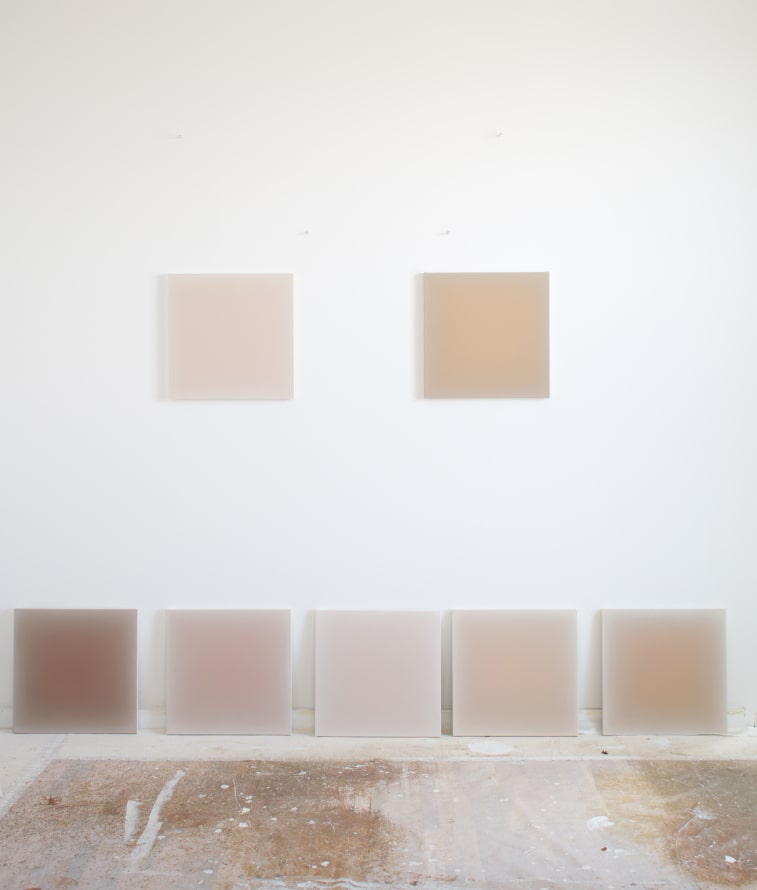
Series of 20 in squares on studio wall, 2021
What is the aim of your art, your work, what is it supposed to achieve in the viewer
The act of perception has always been an integral consideration in my work. When I studied the live model from observation I thought about the attitude towards the subject as much as simply depicting what I saw. This resurfaced in different ways. For example, in the series of skin tondos–which predates this work–I rendered the skin so close up that it was impossible to identify where on the body it was. My aim then was to replace the objectification of the body with a vantage point of extreme proximity. My recent square paintings take this approach even further. The vantage point is now located somewhere between the outer edge of the body and the interior spaces of the mind, creating an illusion of movement back and forth between these two dimensions. Now, the main agents of expression are the colors and gradients–how they behave within the square canvas and how they engage the act of perception.
I hope my work can disarm people–gently! – the colors should be inviting and stimulate feelings of openness, depth, connection, but also a sense of the unquantifiable, the unknown and something of our shared humanity.
THE DEED | THE WORK is a complementary and separately presented part of THE INTERVIEW IN|DEEDS with Gwen Hardie.
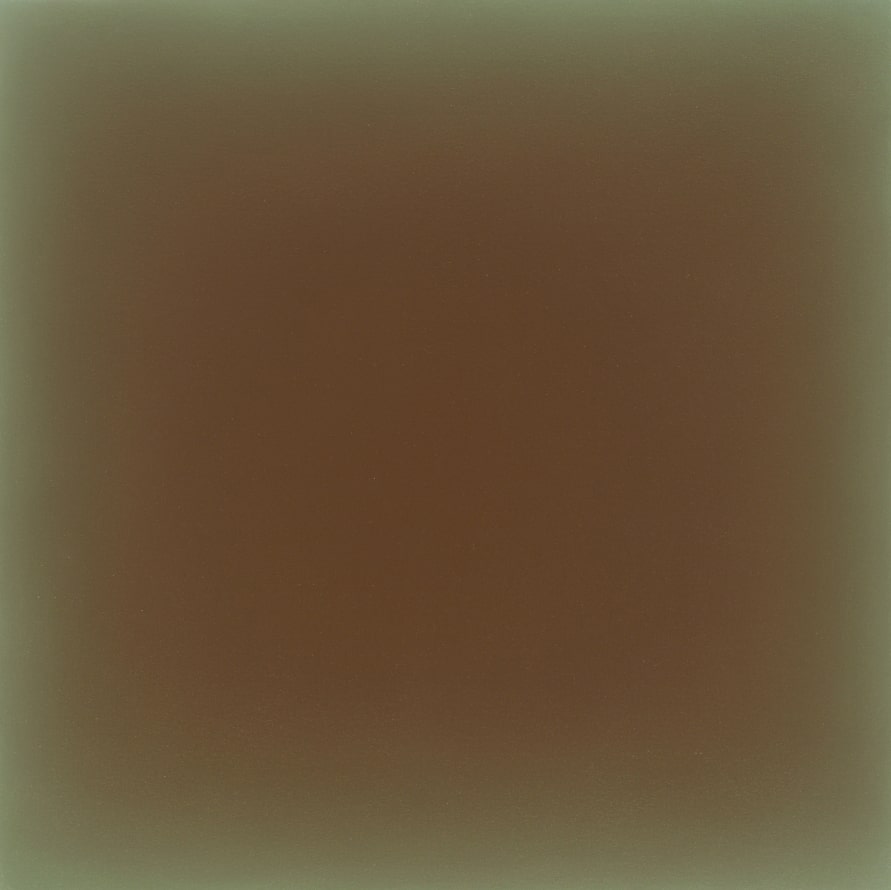
How do you protect yourself from too much inspiration these days?
—
How much in your works is planned beforehand – how much is created intuitively?
I stay within an overarching theme for a long time, investigating infinite variations. I don’t need to plan anything; rather, one painting triggers the curiosity for another.
What are your (next) goals?
Devoted to the present moment and open to the next–surprisingly difficult!
What is your opinion about faith? Do you have principles of faith or is there a motto?
Live in the present and give yourself wholeheartedly to whatever you are doing.
Which project would you still like to realize, if lack of time, courage or financial resources?
In an ideal world, I would like to explore the quality of light more precisely in a show with my work. There are two ideal scenarios–one with ambient indirect light falling equally on all four sides of every painting (not an easy task for a gallery)–and the other would be presenting a series of paintings under a skylit, north facing round or square large space. In both scenarios I would like very high ceilings and at least twice the width of the paintings between each other to allow the colors to breathe and expand perceptually. Oh yes–I can imagine it!

What do you consider to be attributes of good art?
I look for depth and expansiveness and to be convinced that the artist’s visual language is perfectly suited to the purpose and meaning of their art.
Is one born as an artist? Or is studying art compulsory in your view?
Studying art in itself won’t make an artist. It’s so demanding and challenging to stay true to your ideas and develop them in a world which may not care. An artist has to have this irrational belief in themself that comes from somewhere.
To whom do you show a new work first?
Probably social media…I do it without thinking too much…eventually my husband, gallerists, friends.
What does the first hour of your day look like?
Coffee, catching up on emails over breakfast.
in Times of the internet of things, are galleries still necessary? If so, why and what for?
Yes, galleries are still necessary. Social media is brilliant for sharing images across the globe, but as a viewing experience, it can’t compete with the direct encounter a gallery offers.

Social media – in your view a blessing or a curse?
I think more of a blessing than a curse: I love its global reach. Personally I am pleased to find connections with artists aesthetically from so many different countries.
EPILOGUE | CURRENT
The solo exhibition Human Boundaries of Gwen Hardie is on view from 6th November 2021 until 8th January 2022 at the gallery Pugliese Levi, Auguststraße 62, 10117 Berlin-Mitte.
www.instagram.com/gwenhardie1436
In times of Corona, when travel, studio visits and personal contacts are inappropriate or even impossible, the written interview remains an important medium to introduce artist personalities, to spread their messages and to stay in touch with art lovers. The interviews are not edited or shortened by the editors and are always reproduced in original sound. Therefore, we do not translate the interview into English or German unle






